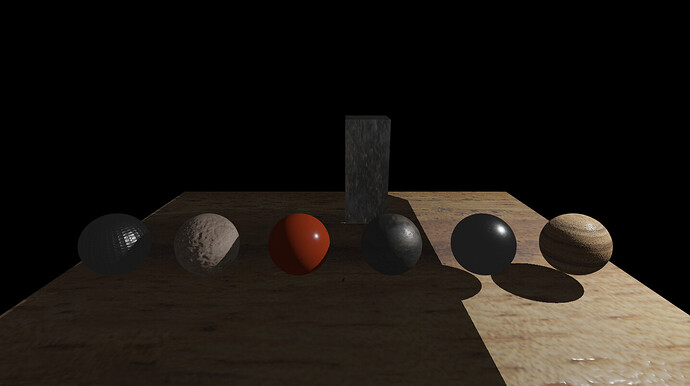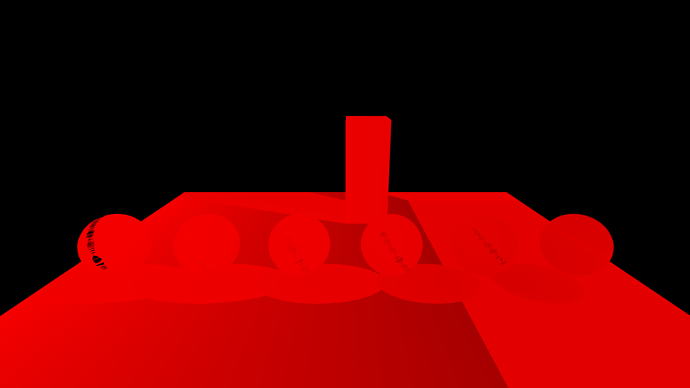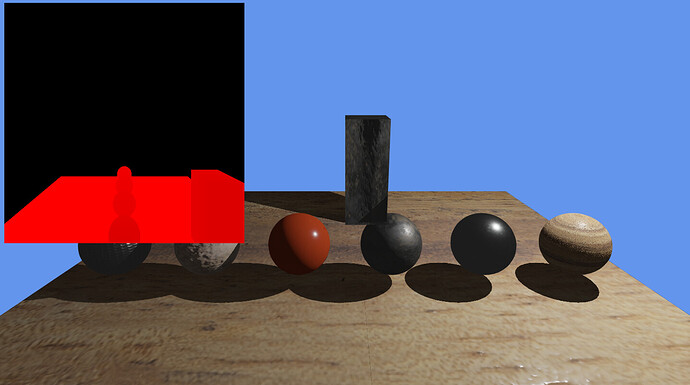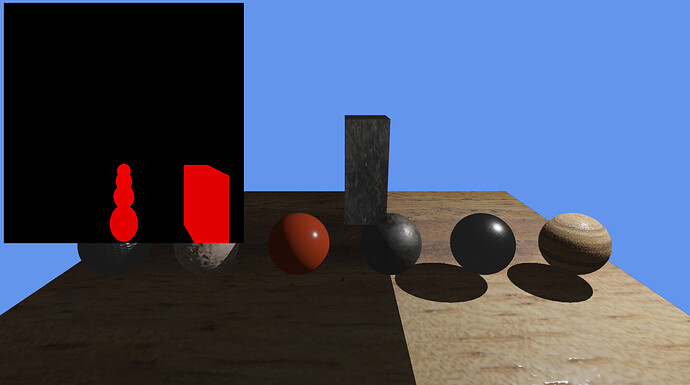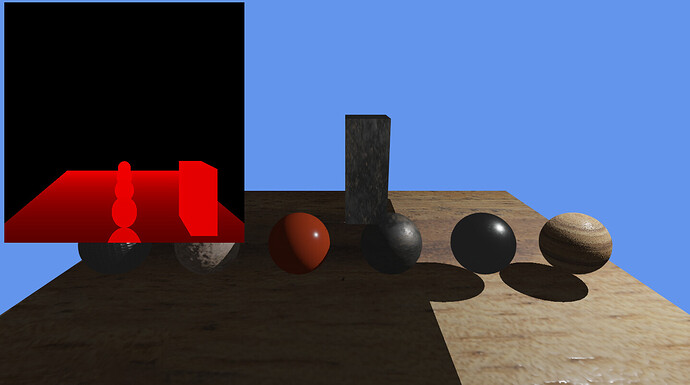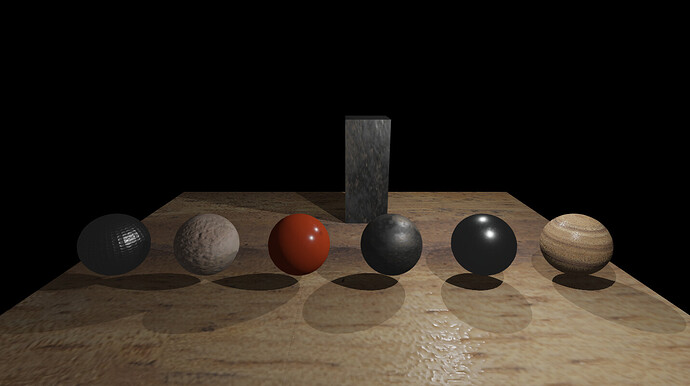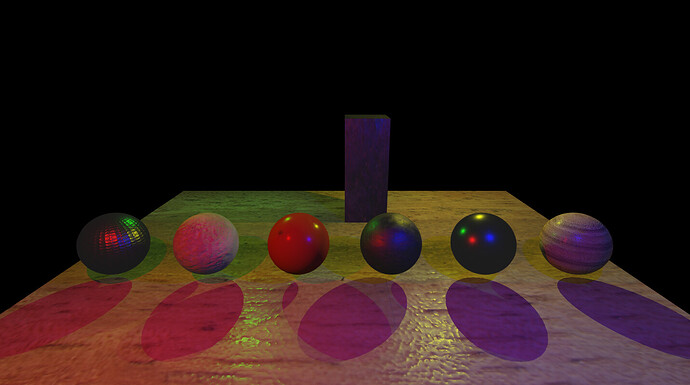I cobbled it together from a bunch of things I read. I’d say I understand it about 80% which is not enough to really write an informed tutorial. Happy to share the code though.
This is my shader, it uses PBR lighting and has shadow mapping for 1 directional light and up to 8 point lights.
My sources are:
PBR shader based on https://learnopengl.com/PBR/Lighting
Shadow maps based on Shadow mapping on Monogame
A few caveats: It is definitely not the most efficient or well written shader, my focus was just on getting it working. Also it uses an array of 6 textures to do the point light shadows instead of a cube map which leads to seams along the edges.
So with all that said, here’s the code 
//----------------------------------------------------------------------------------
// Standard defines
//----------------------------------------------------------------------------------
#if OPENGL
#define SV_POSITION POSITION
#define VS_SHADERMODEL vs_3_0
#define PS_SHADERMODEL ps_3_0
#else
#define VS_SHADERMODEL vs_5_0
#define PS_SHADERMODEL ps_5_0
#endif
//----------------------------------------------------------------------------------
// Properties
//----------------------------------------------------------------------------------
float4x4 _World;
float4x4 _View;
float4x4 _Projection;
float3 _CameraPos;
float4 _Color;
Texture2D _Albedo;
Texture2D _Metalness;
Texture2D _Displacement;
Texture2D _Normal;
Texture2D _Roughness;
Texture2D _AO;
//Lights
static const int MaxDirectionalLights = 8;
static const int MaxPointLights = 8;
static const int CubeSides = 6;
static const float3 FaceDirectons[CubeSides] = {
float3(1, 0, 0),
float3(-1, 0, 0),
float3(0, 1, 0),
float3(0, -1, 0),
float3(0, 0, 1),
float3(0, 0, -1),
};
float3 _AmbientColor;
float3 _DirectionalLights[MaxDirectionalLights];
float3 _DirectionalColors[MaxDirectionalLights];
float _DirectionalIntensity[MaxDirectionalLights];
float3 _PointLightPos[MaxPointLights];
float3 _PointLightColors[MaxPointLights];
float _PointLightIntensity[MaxPointLights];
float _PointLightRange[MaxPointLights];
//Shadows
Texture2D _DirectionalShadowMap;
SamplerState DirectionalShadowMapSampler
{
Texture = (_DirectionalShadowMap);
MinFilter = point;
MagFilter = point;
MipFilter = point;
AddressU = Wrap;
AddressV = Wrap;
};
Texture2DArray _PointShadowMap;
SamplerState PointShadowMapSampler
{
Texture = (_PointShadowMap);
MinFilter = point;
MagFilter = point;
MipFilter = point;
AddressU = Wrap;
AddressV = Wrap;
};
float4x4 _LightSpaceMatrix;
float4x4 _PointLightSpaceMatrix[MaxPointLights * CubeSides];
int _ShadowMapSize;
float _DepthBias;
int _DirectionalShadowIndex;
//----------------------------------------------------------------------------------
static const float PI = 3.14159265359;
//----------------------------------------------------------------------------------
// Required attributes of the input vertices
//----------------------------------------------------------------------------------
struct VertexShaderInput
{
float3 Position : POSITION0;
float3 Normal : NORMAL;
//float3 Tangent : TANGENT;
//float3 Binormal : BINORMAL;
float2 TextureUV : TEXCOORD0;
};
// Semantics for output of vertex shader / input of pixel shader
struct VertexShaderOutput
{
float4 Position : SV_POSITION;
float2 TextureUV : TEXCOORD0;
float3 Normal : TEXCOORD1;
//float3 Tangent : TEXCOORD2;
//float3 Binormal : TEXCOORD3;
float3 WorldPosition : TEXCOORD2;
};
SamplerState MeshTextureSampler
{
Filter = Anisotropic;
AddressU = Wrap;
AddressV = Wrap;
};
//----------------------------------------------------------------------------------
// PBR equations
//----------------------------------------------------------------------------------
float3 fresnelSchlick(float cosTheta, float3 F0)
{
cosTheta = min(cosTheta, 1.0);
return F0 + (1.0 - F0) * pow(1.0 - cosTheta, 5.0);
}
float DistributionGGX(float3 N, float3 H, float roughness)
{
float a = roughness * roughness;
float a2 = a * a;
float NdotH = max(dot(N, H), 0.0);
float NdotH2 = NdotH * NdotH;
float num = a2;
float denom = (NdotH2 * (a2 - 1.0) + 1.0);
denom = PI * denom * denom;
return num / denom;
}
float GeometrySchlickGGX(float NdotV, float roughness)
{
float r = (roughness + 1.0);
float k = (r * r) / 8.0;
float num = NdotV;
float denom = NdotV * (1.0 - k) + k;
return num / denom;
}
float GeometrySmith(float3 N, float3 V, float3 L, float roughness)
{
float NdotV = max(dot(N, V), 0.0);
float NdotL = max(dot(N, L), 0.0);
float ggx2 = GeometrySchlickGGX(NdotV, roughness);
float ggx1 = GeometrySchlickGGX(NdotL, roughness);
return ggx1 * ggx2;
}
//Generating tangents and binormals based on https://github.com/JoeyDeVries/LearnOpenGL/blob/master/src/6.pbr/1.2.lighting_textured/1.2.pbr.fs
float3 getNormalFromMap(VertexShaderOutput input)
{
float3 tangentNormal = _Normal.Sample(MeshTextureSampler, input.TextureUV).rgb;
tangentNormal = normalize(tangentNormal * 2.0 - 1.0);
float3 Q1 = ddx(input.WorldPosition);
float3 Q2 = ddy(input.WorldPosition);
float2 st1 = ddx(input.TextureUV);
float2 st2 = ddy(input.TextureUV);
float3 N = normalize(input.Normal);
float3 T = -normalize(Q1 * st2.y - Q2 * st1.y);
float3 B = normalize(cross(N, T));
//float3 N = normalize(input.Normal);
//float3 T = normalize(input.Tangent);
//float3 B = normalize(input.Binormal);
float3x3 TBN = float3x3(T, B, N);
return normalize(mul(tangentNormal, TBN));
}
//----------------------------------------------------------------------------------
// Directional lights: Calculates the shadow term using PCF
//----------------------------------------------------------------------------------
float CalcDirectionalShadowsPCF(float light_space_depth, float ndotl, float2 shadow_coord)
{
float shadow_term = 0;
float variableBias = clamp(0.001 * tan(acos(ndotl)), 0, _DepthBias);
//safe to assume it's a square
float size = 1.0 / _ShadowMapSize;
float samples[4];
samples[0] = (light_space_depth - variableBias < _DirectionalShadowMap.Sample(DirectionalShadowMapSampler, shadow_coord).r);
samples[1] = (light_space_depth - variableBias < _DirectionalShadowMap.Sample(DirectionalShadowMapSampler, shadow_coord + float2(size, 0)).r);
samples[2] = (light_space_depth - variableBias < _DirectionalShadowMap.Sample(DirectionalShadowMapSampler, shadow_coord + float2(0, size)).r);
samples[3] = (light_space_depth - variableBias < _DirectionalShadowMap.Sample(DirectionalShadowMapSampler, shadow_coord + float2(size, size)).r);
shadow_term = (samples[0] + samples[1] + samples[2] + samples[3]) / 4.0;
return shadow_term;
}
//----------------------------------------------------------------------------------
// Point Lights: Calculates the shadow term using PCF
//----------------------------------------------------------------------------------
float CalcPointShadowsPCF(float light_space_depth, float ndotl, float3 shadow_coord)
{
float shadow_term = 0;
float variableBias = clamp(0.001 * tan(acos(ndotl)), 0, _DepthBias);
float size = 1.0 / _ShadowMapSize;
float samples[4];
samples[0] = (light_space_depth - variableBias < _PointShadowMap.Sample(PointShadowMapSampler, shadow_coord).r);
samples[1] = (light_space_depth - variableBias < _PointShadowMap.Sample(PointShadowMapSampler, shadow_coord + float3(size, 0, 0)).r);
samples[2] = (light_space_depth - variableBias < _PointShadowMap.Sample(PointShadowMapSampler, shadow_coord + float3(0, size, 0)).r);
samples[3] = (light_space_depth - variableBias < _PointShadowMap.Sample(PointShadowMapSampler, shadow_coord + float3(size, size, 0)).r);
shadow_term = (samples[0] + samples[1] + samples[2] + samples[3]) / 4.0;
return shadow_term;
}
//----------------------------------------------------------------------------------
// Lights
//----------------------------------------------------------------------------------
float3 CalculatePointLights(float3 worldPosition, float3 N, float3 albedo, float metallic, float roughness)
{
float3 V = normalize(_CameraPos - worldPosition);
//Calculate surface reflection at zero incidence, default to 0.04 but adjust for metallic surfaces.
float3 F0 = float3(0.04, 0.04, 0.04);
F0 = lerp(F0, albedo, metallic);
//Reflection equation
float3 Lo = float3(0.0, 0.0, 0.0);
for(int i = 0; i < MaxPointLights; ++i)
{
// calculate per-light radiance
float3 L = normalize(_PointLightPos[i] - worldPosition);
float3 H = normalize(V + L);
float distance = length(_PointLightPos[i] - worldPosition);
float attenuation = _PointLightRange[i] / (distance * distance);
float3 radiance = _PointLightColors[i] * attenuation * _PointLightIntensity[i];
// cook-torrance brdf
float NDF = DistributionGGX(N, H, roughness);
float G = GeometrySmith(N, V, L, roughness);
float3 F = fresnelSchlick(max(dot(H, V), 0.0), F0);
float3 kS = F;
float3 kD = float3(1.0, 1.0, 1.0) - kS;
kD *= 1.0 - metallic;
float3 numerator = NDF * G * F;
float denominator = 4.0 * max(dot(N, V), 0.0) * max(dot(N, L), 0.0);
float3 specular = numerator / max(denominator, 0.001);
// add to outgoing radiance Lo
float NdotL = max(dot(N, L), 0.0);
//Shadows
float shadowContribution = 1.0;
//Work out which face of the shadow cube
float3 directionToFragment = normalize(worldPosition - _PointLightPos[i]);
float closestDirection = -1;
int faceIndex = 0;
for(int face = 0; face < CubeSides; ++face)
{
float3 forward = FaceDirectons[face];
float result = dot(directionToFragment, forward);
if(result > closestDirection)
{
closestDirection = result;
faceIndex = face;
}
}
int arrayIndex = i * CubeSides + faceIndex;
float4 lightingPosition = mul(float4(worldPosition, 1), _PointLightSpaceMatrix[arrayIndex]);
float2 shadowTexCoord = mad(0.5, lightingPosition.xy / lightingPosition.w, float2(0.5, 0.5));
shadowTexCoord.y = 1.0f - shadowTexCoord.y;
float ourDepth = (lightingPosition.z / lightingPosition.w);
shadowContribution = CalcPointShadowsPCF(ourDepth, NdotL, float3(shadowTexCoord, arrayIndex));
Lo += (kD * albedo / PI + specular) * radiance * NdotL * shadowContribution;
}
return Lo;
}
float3 CalculateDirectionalLights(float3 worldPosition, float3 N, float3 albedo, float metallic, float roughness)
{
float3 V = normalize(_CameraPos - worldPosition);
//Calculate surface reflection at zero incidence, default to 0.04 but adjust for metallic surfaces.
float3 F0 = float3(0.04, 0.04, 0.04);
F0 = lerp(F0, albedo, metallic);
//Reflection equation
float3 Lo = float3(0.0, 0.0, 0.0);
for(int i = 0; i < MaxDirectionalLights; ++i)
{
// calculate per-light radiance
float3 L = -_DirectionalLights[i];
float3 H = normalize(V + L);
float3 radiance = _DirectionalColors[i] * _DirectionalIntensity[i];
// cook-torrance brdf
float NDF = DistributionGGX(N, H, roughness);
float G = GeometrySmith(N, V, L, roughness);
float3 F = fresnelSchlick(max(dot(H, V), 0.0), F0);
float3 kS = F;
float3 kD = float3(1.0, 1.0, 1.0) - kS;
kD *= 1.0 - metallic;
float3 numerator = NDF * G * F;
float denominator = 4.0 * max(dot(N, V), 0.0) * max(dot(N, L), 0.0);
float3 specular = numerator / max(denominator, 0.001);
float NdotL = max(dot(N, L), 0.0);
//Shadows
float shadowContribution = 1.0;
if(i == _DirectionalShadowIndex)
{
float4 lightingPosition = mul(float4(worldPosition, 1), _LightSpaceMatrix);
float2 shadowTexCoord = mad(0.5, lightingPosition.xy / lightingPosition.w, float2(0.5, 0.5));
shadowTexCoord.y = 1.0f - shadowTexCoord.y;
float ourDepth = (lightingPosition.z / lightingPosition.w);
shadowContribution = CalcDirectionalShadowsPCF(ourDepth, NdotL, shadowTexCoord);
}
// add to outgoing radiance Lo
Lo += (kD * albedo / PI + specular) * radiance * NdotL * shadowContribution;
}
return Lo;
}
//----------------------------------------------------------------------------------
// Actual shaders
//----------------------------------------------------------------------------------
VertexShaderOutput MainVS(in VertexShaderInput input)
{
VertexShaderOutput output = (VertexShaderOutput)0;
//Position
float4 worldPosition = mul(float4(input.Position.xyz, 1), _World);
float4 viewPosition = mul(worldPosition, _View);
output.Position = mul(viewPosition, _Projection);
output.WorldPosition = worldPosition.xyz;
//Normals
output.Normal = mul(input.Normal, (float3x3)_World);
output.Normal = normalize(output.Normal);
//UVs
output.TextureUV = input.TextureUV;
return output;
}
float4 MainPS(VertexShaderOutput input) : COLOR
{
//Read textures
float3 albedo = _Albedo.Sample(MeshTextureSampler, input.TextureUV).xyz;
float metallic = _Metalness.Sample(MeshTextureSampler, input.TextureUV).r;
float roughness = _Roughness.Sample(MeshTextureSampler, input.TextureUV).r;
float ao = _AO.Sample(MeshTextureSampler, input.TextureUV).r;
float3 normal = getNormalFromMap(input);
//Convert albedo to linear space
albedo = pow(abs(albedo), 2.2);
//Point lights
float3 Lo = CalculatePointLights(input.WorldPosition, normal, albedo, metallic, roughness);
Lo += CalculateDirectionalLights(input.WorldPosition, normal, albedo, metallic, roughness);
//Final colours
float3 ambient = _AmbientColor * albedo * ao;
float3 color = ambient + Lo;
color = color / (color + float3(1.0, 1.0, 1.0));
color = pow(abs(color), float3(1.0 / 2.2, 1.0 / 2.2, 1.0 / 2.2));
return float4(color, 1.0);
}
//----------------------------------------------------------------------------------
// Technique and passes within the technique
//----------------------------------------------------------------------------------
technique MainEffect
{
pass Pass0
{
VertexShader = compile VS_SHADERMODEL MainVS();
PixelShader = compile PS_SHADERMODEL MainPS();
}
}
